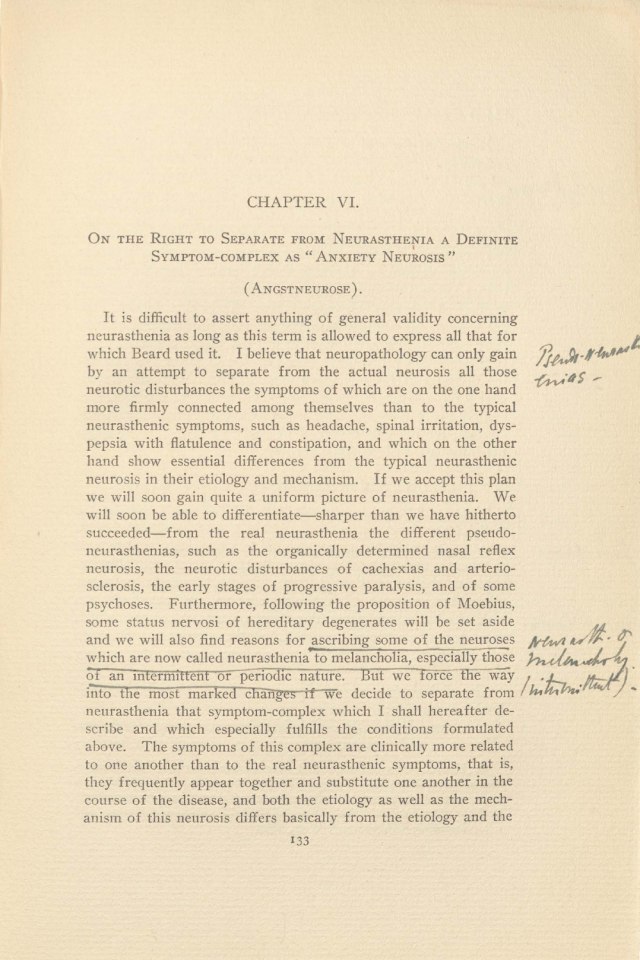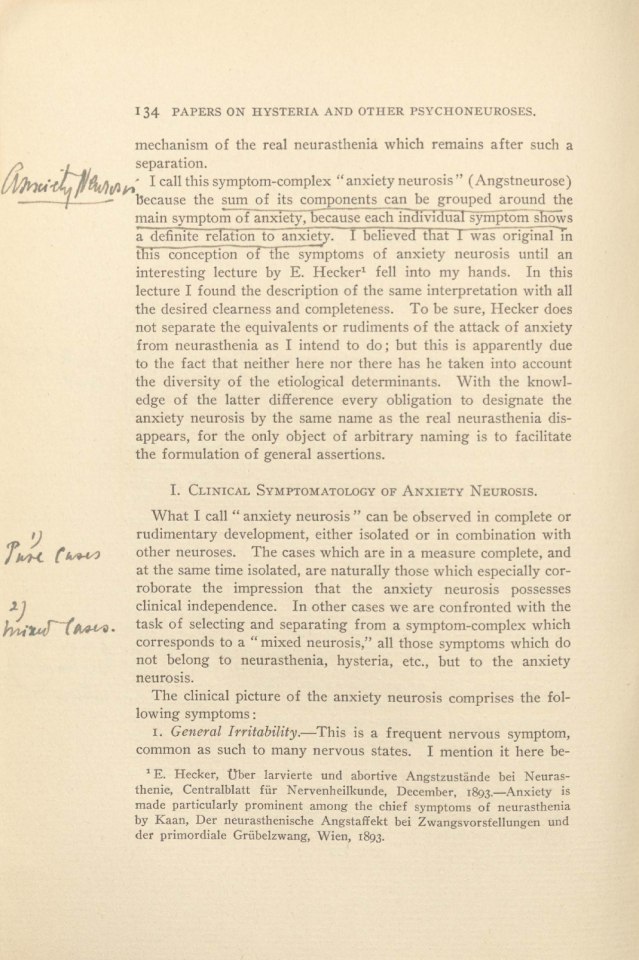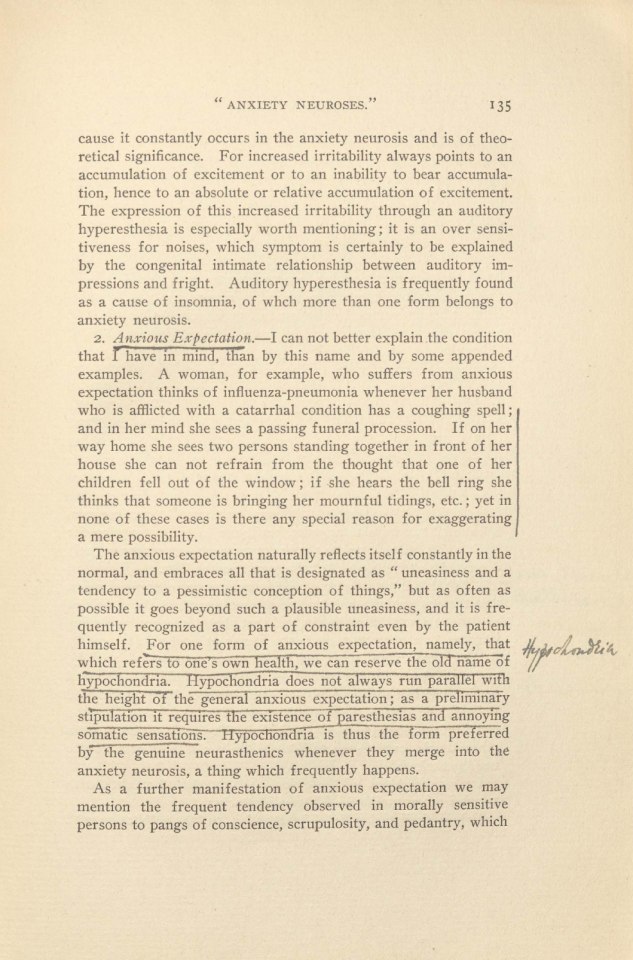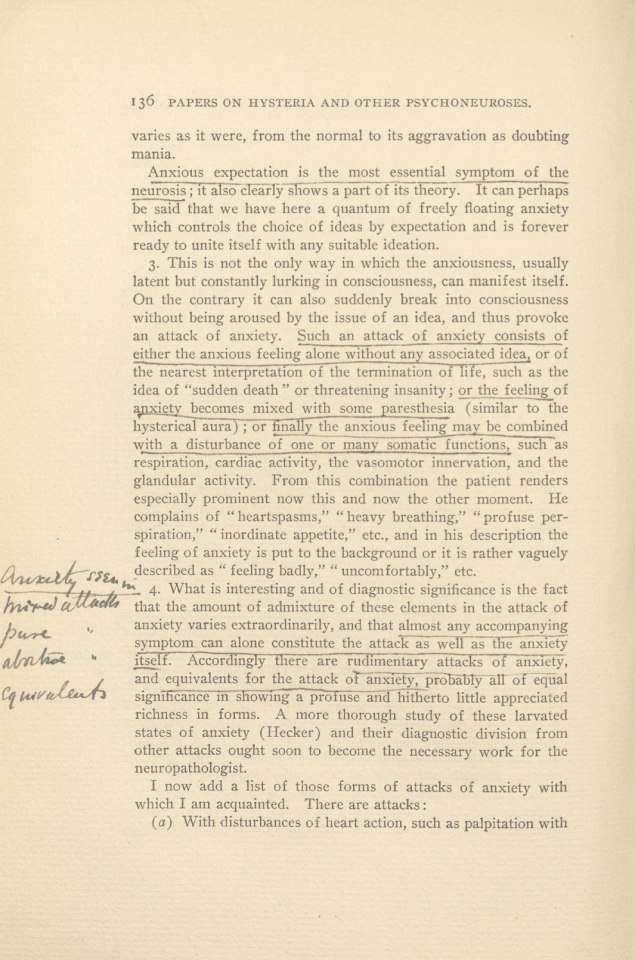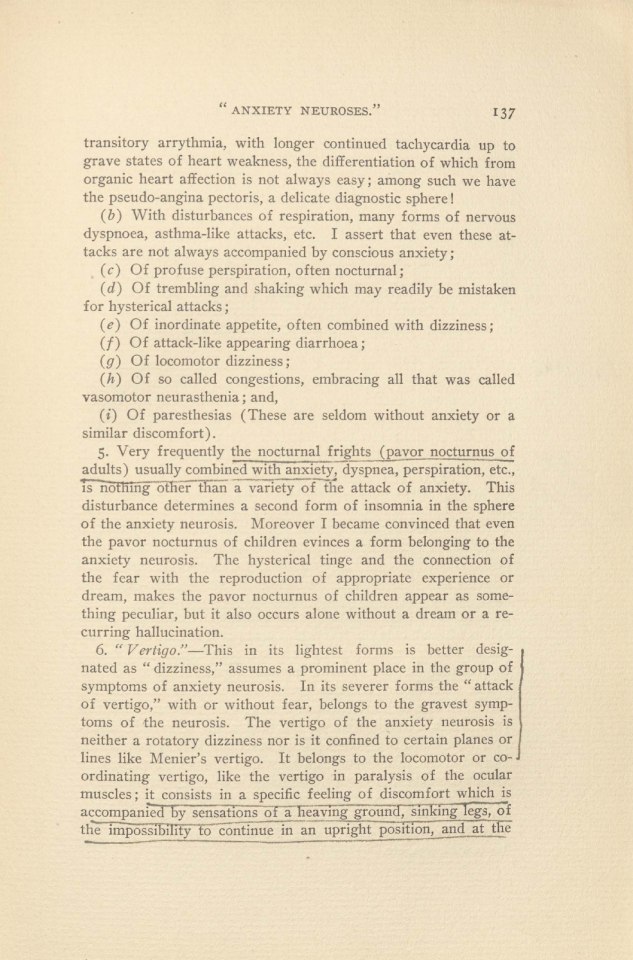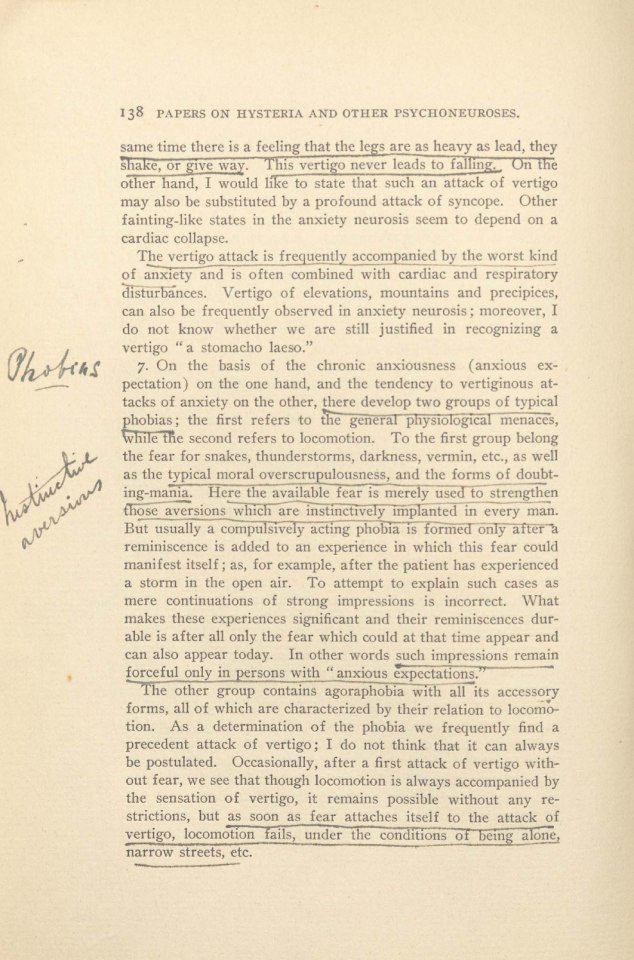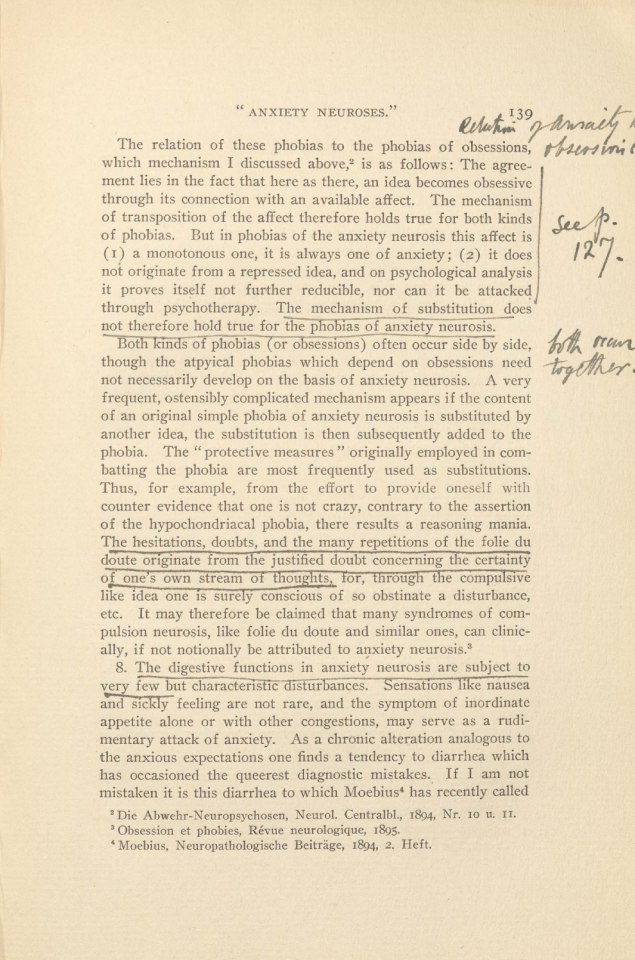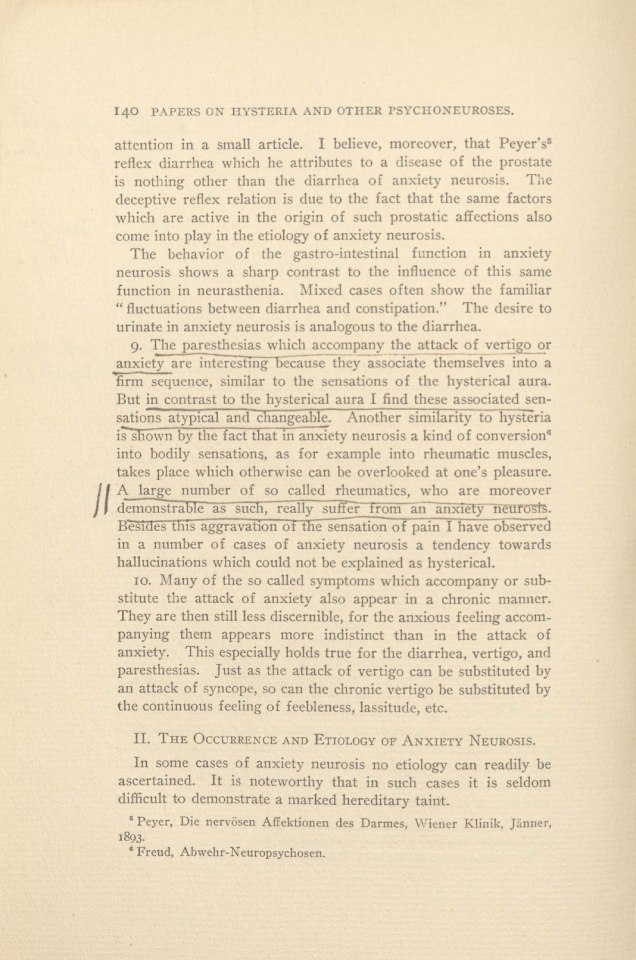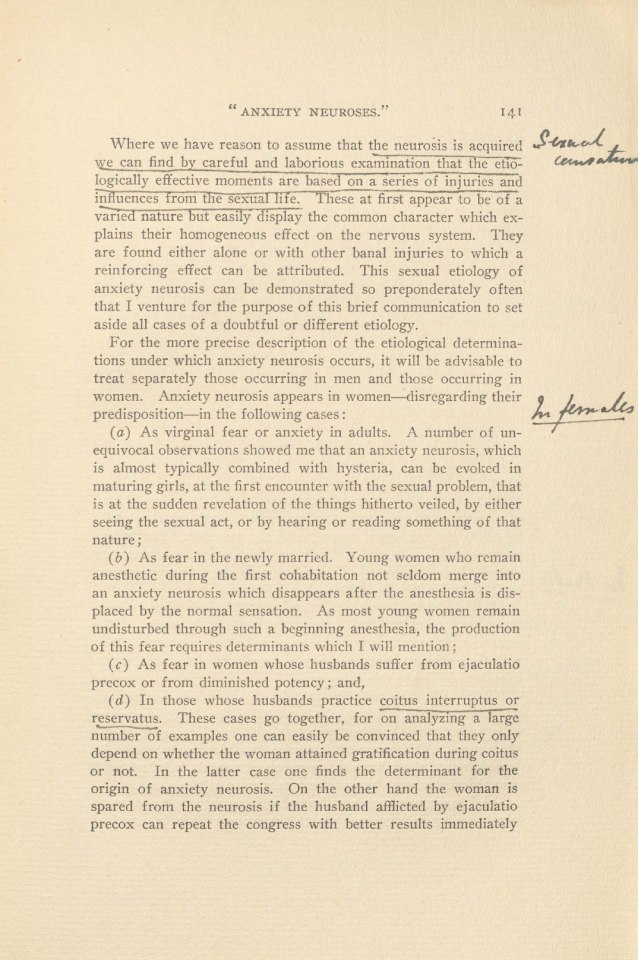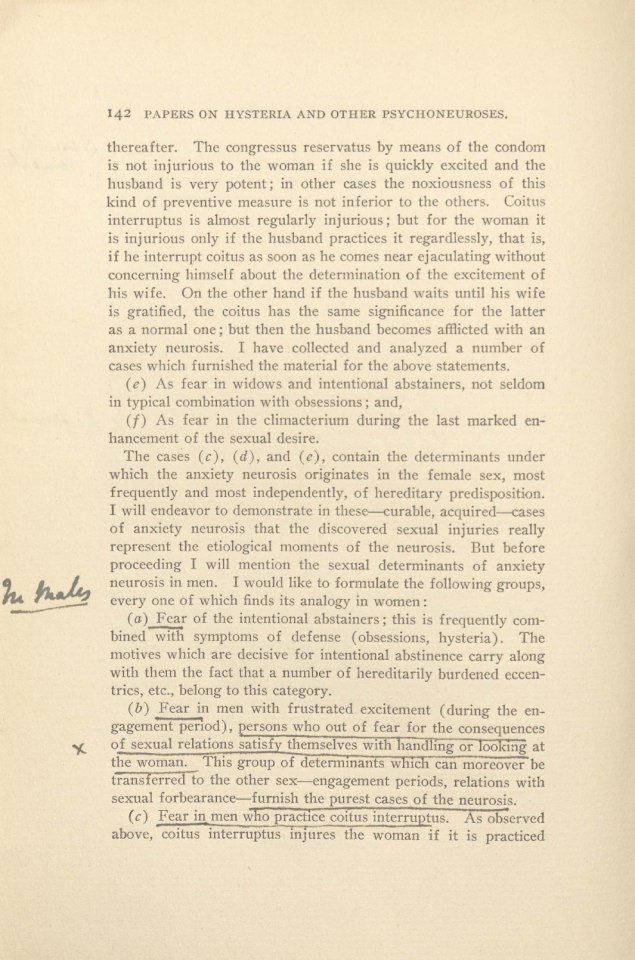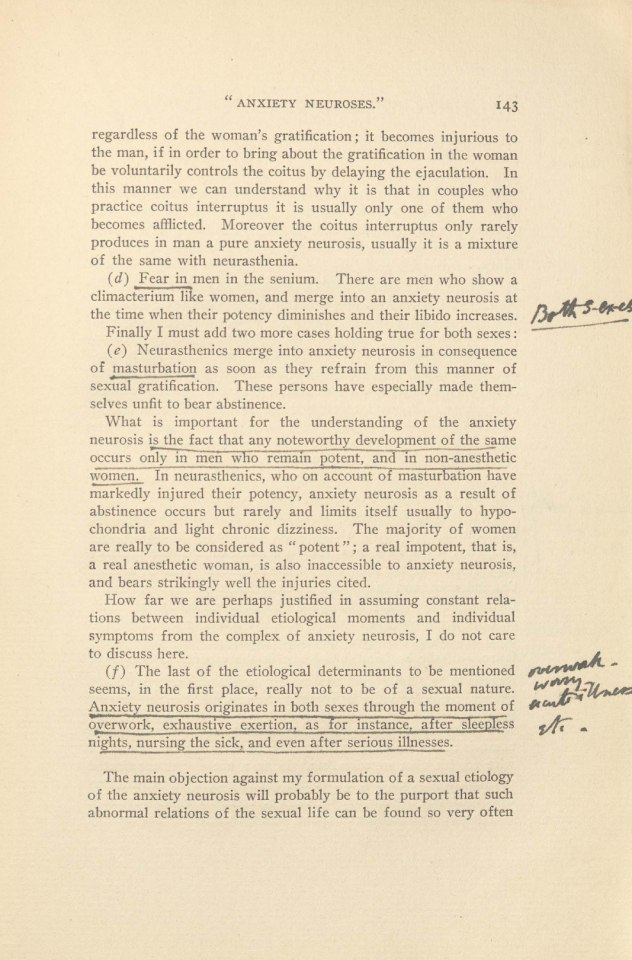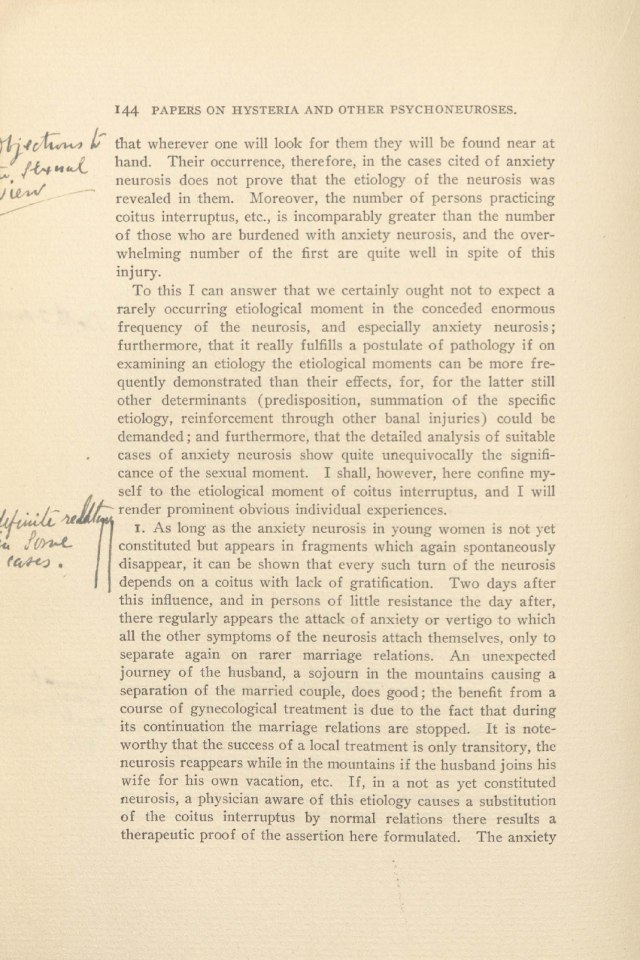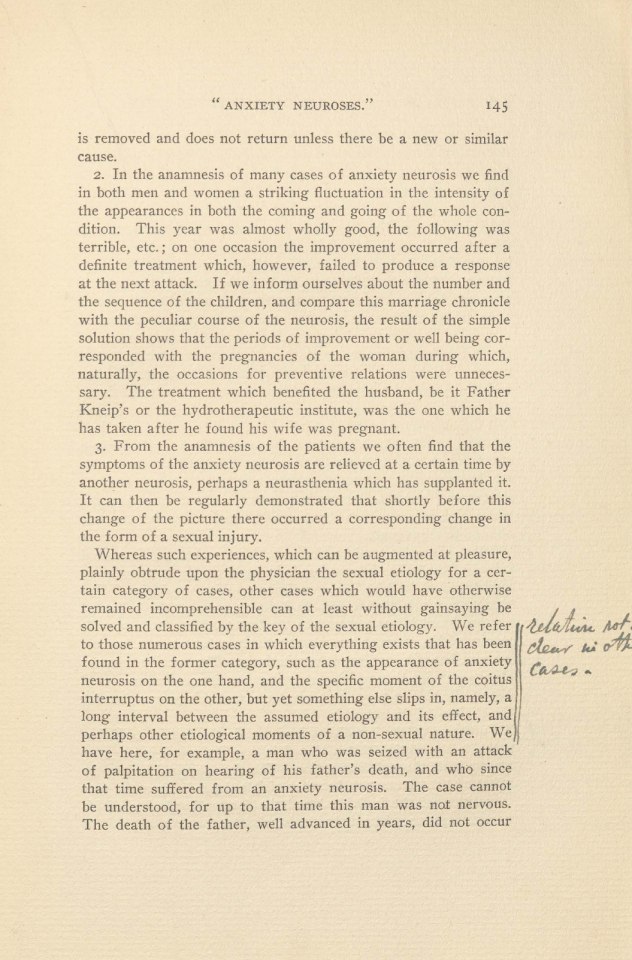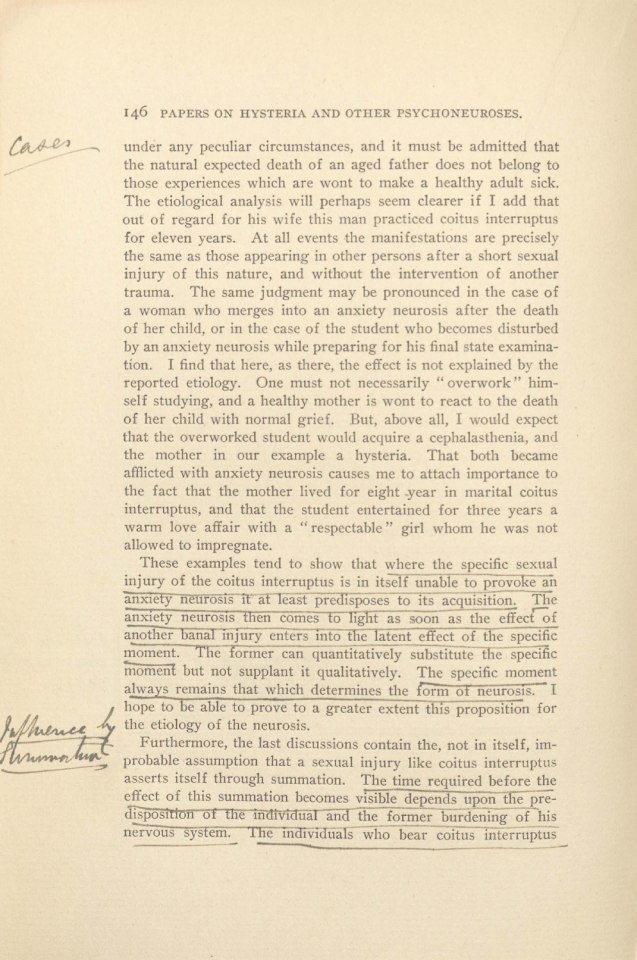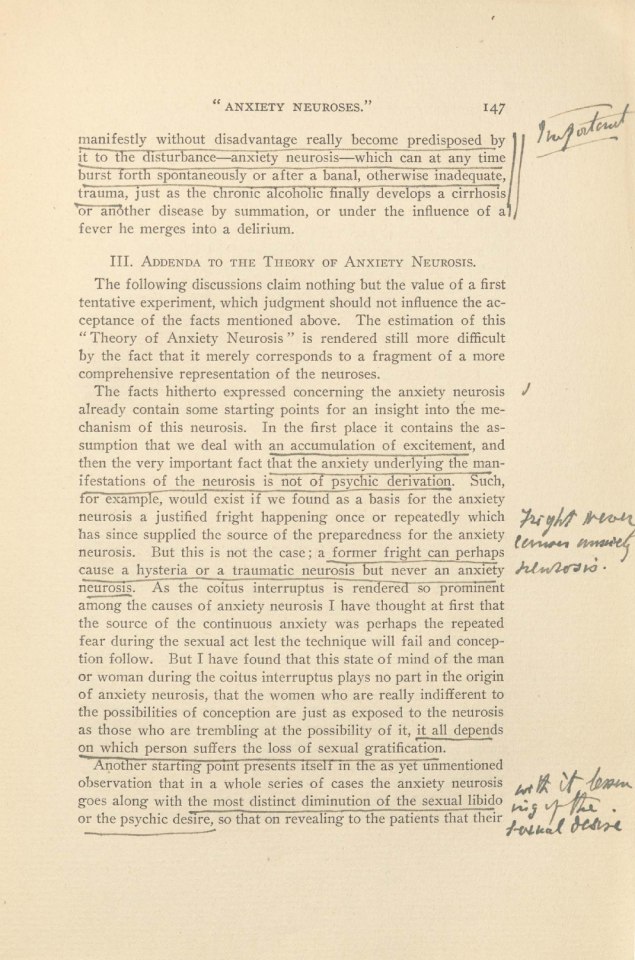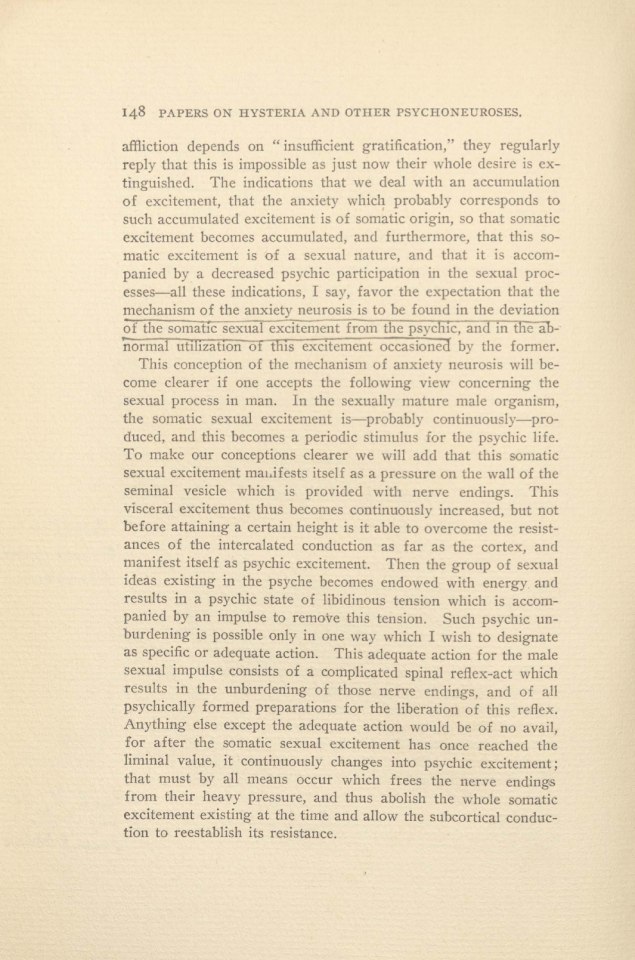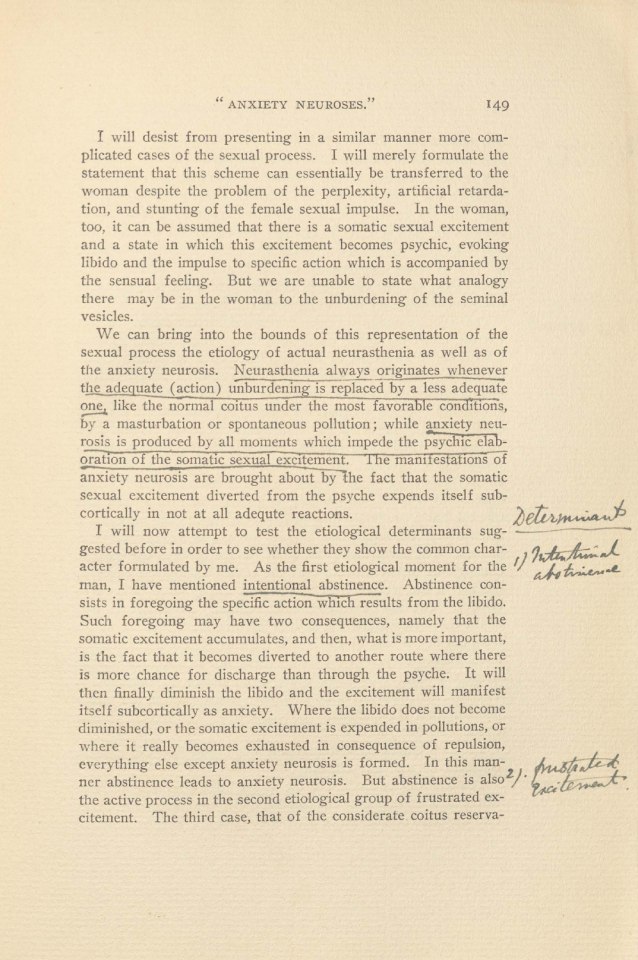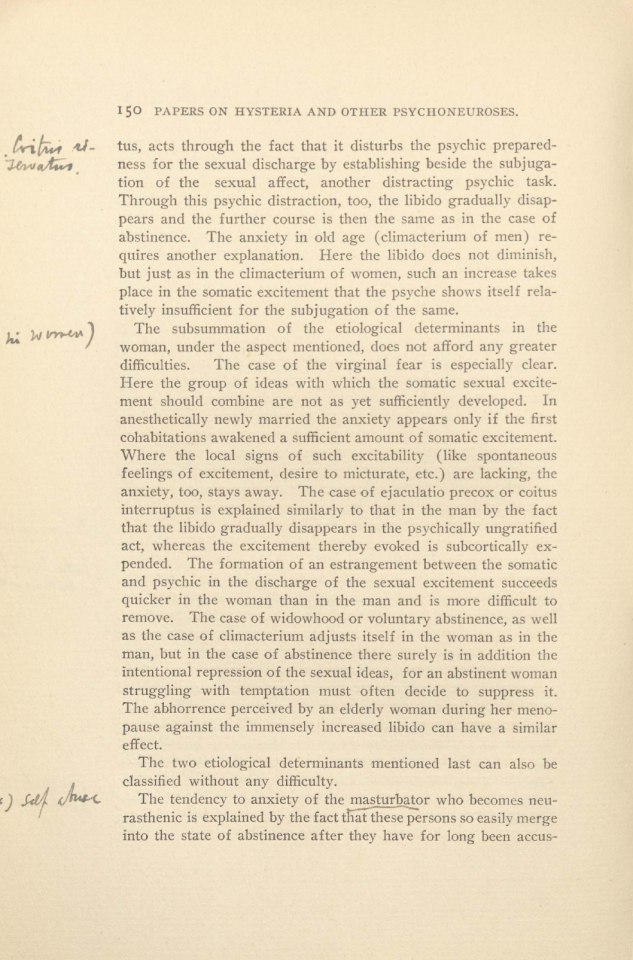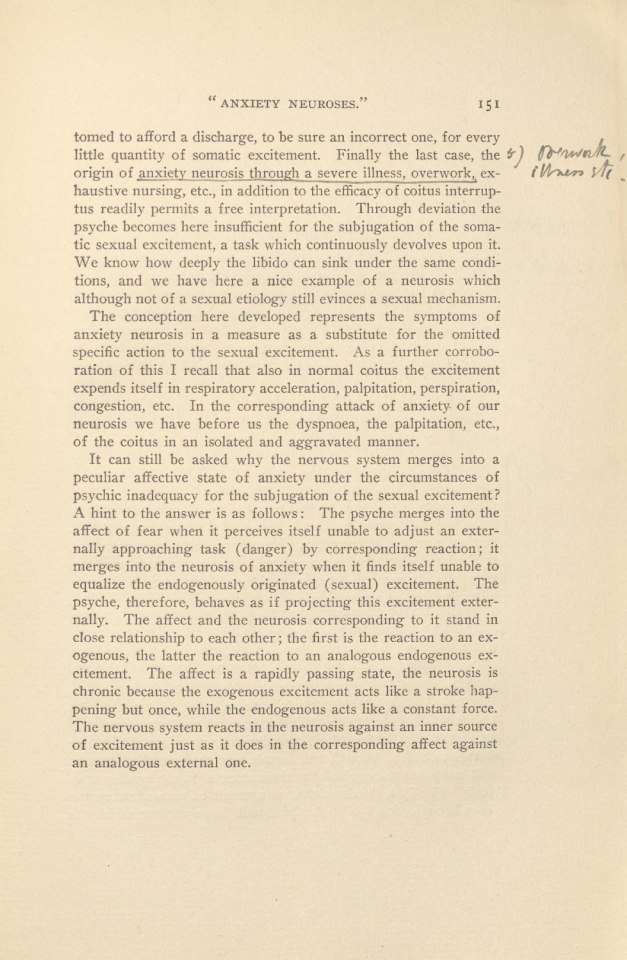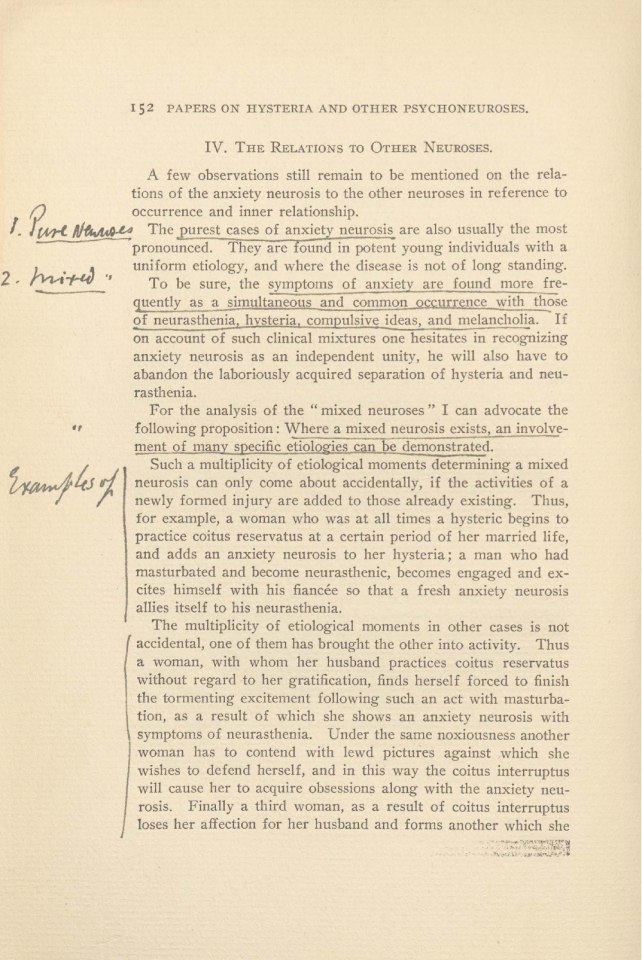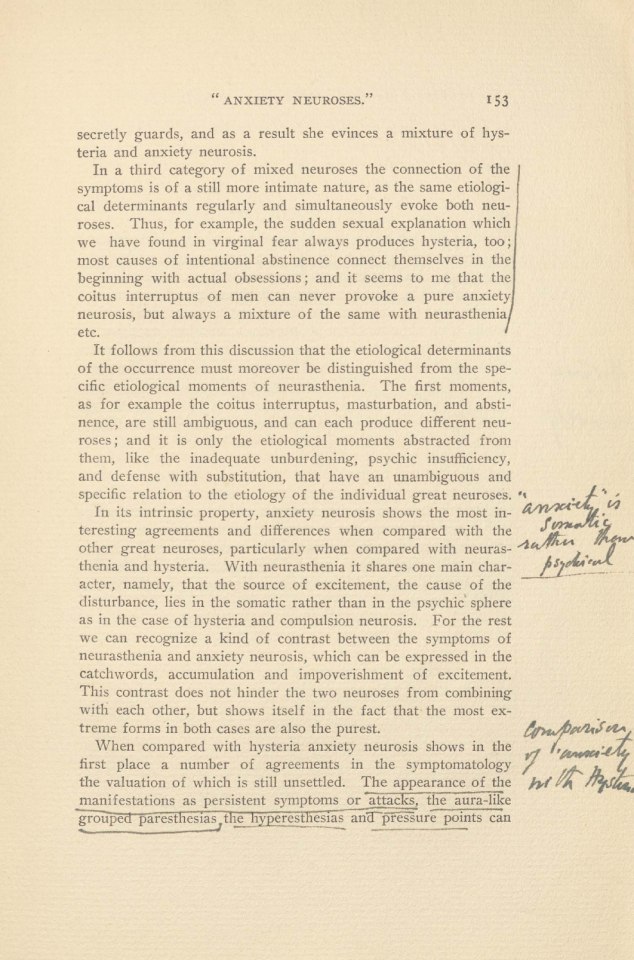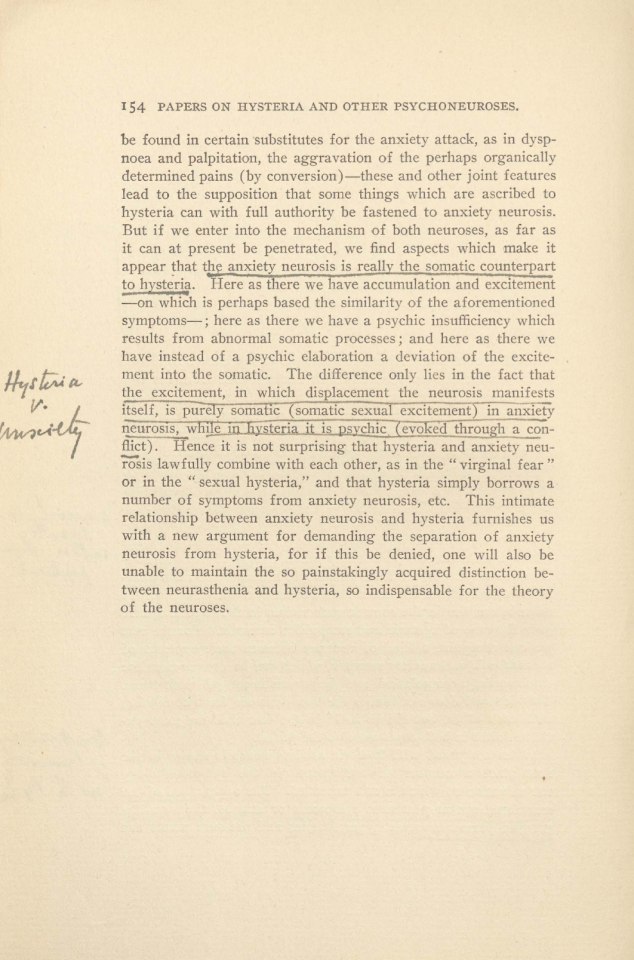S.
CHAPTER VL
ON THE RIGHT TO SEPARATE FROM NEURASTHENIA A DEFINITE
SYMPTOM-COMPLEX AS “ ANXIETY NEUROSIS ”(ANGSTNEUROSE).
Tt is difficult to assert anything of general validity concerning
neurasthenia as long as this term is allowed to express all that for
which Beard used it. I believe that neuropathology can only gain
by an attempt to separate from the actual neurosis all those
neurotic disturbances the symptoms of which are on the one hand
more firmly connected among themselves than to the typical
neurasthenic symptoms, such as headache, spinal irritation, dys-
pepsia with flatulence and constipation, and which on the other
hand show essential differences from the typical neurasthenic
neurosis in their etiology and mechanism. If we accept this plan
we will soon gain quite a uniform picture of neurasthenia. We
will soon be able to differentiate—sharper than we have hitherto
succeeded—from the real neurasthenia the different pseudo-
neurasthenias, such as the organically determined nasal reflex
neurosis, the neurotic disturbances of cachexias and arterio-
sclerosis, the early stages of progressive paralysis, and of some
psychoses. Furthermore, following the proposition of Moebius,
some status nervosi of hereditary degenerates will be set aside
and we will also find reasons for ascribing some of the neuroses
which are now called neurasthenia to melancholia, especially those
Of an intermittent or periodic nature. But we force the way
into the most marked chan if we decide to separate from
neurasthenia that symptom-complex which I shall hereafter de-
scribe and which especially fulfills the conditions formulated
above. The symptoms of this complex are clinically more related
to one another than to the real neurasthenic symptoms, that is,
they frequently appear together and substitute one another in the
course of the disease, and both the etiology as well as the mech-
anism of this neurosis differs basically from the etiology and the133
Nod nt
ア ン タ タ ー
A
/ ん w4
: O
S.
134 PAPERS ON HYSTERIA AND OTHER PSYCHONEUROSES,
mechanism of the real neurasthenia which remains after such a
ク 4 separation.
w の が z I call this symptom-complex “anxiety neurosis” (Angstneurose)A /
4
hurd tar.Because the sum of its components can be grouped around the
main symptom of anxiety, because each individual symptom shows
a definite relation to anxiety. believed that I was original in
this conception of the symptoms of anxiety neurosis until an
interesting lecture by Е. Hecker! fell into my hands. In this
lecture I found the description of the same interpretation with all
the desired clearness and completeness. To be sure, Hecker does
not separate the equivalents or rudiments of the attack of anxiety
from neurasthenia as I intend to do; but this is apparently due
to the fact that neither here nor there has he taken into account
the diversity of the etiological determinants. With the knowl-
edge of the latter difference every obligation to designate the
anxiety neurosis by the same name as the real neurasthenia dis-
appears, for the only object of arbitrary naming is to facilitate
the formulation of general assertions.I. CLINICAL SYMPTOMATOLOGY OF ANXIETY NEUROSIS.
What I call “ anxiety neurosis” can be observed in complete or
rudimentary development, either isolated or in combination with
other neuroses. The cases which are in a measure complete, and
at the same time isolated, are naturally those which especially cor-
roborate the impression that the anxiety neurosis possesses
clinical independence. In other cases we are confronted with the
task of selecting and separating from a symptom-complex which
corresponds to a “mixed neurosis,” all those symptoms which do
not belong to neurasthenia, hysteria, etc., but to the anxiety
neurosis.The clinical picture of the anxiety neurosis comprises the fol-
lowing symptoms:1. General Irritability —This is a frequent nervous symptom,
common as such to many nervous states. I mention it here be-ТЕ. Hecker, Über larvierte und abortive Angstzustinde bei Neuras-
thenie, Centralblatt für Nervenheilkunde, December, 1893. —Anxiety is
made particularly prominent among the chief symptoms of neurastheniaby Kaan, Der neurasthenische Angstaffekt bei Zwangsvorstellungen und
der primordiale Griibelzwang, Wien, 1893.S.
* ANXIETY NEUROSES.” 135
cause it constantly occurs in the anxiety neurosis and is of theo-
retical significance. For increased irritability always points to an
accumulation of excitement or to an inability to bear accumula-
tion, hence to an absolute or relative accumulation of excitement.
The expression of this increased irritability through an auditory
hyperesthesia is especially worth mentioning; it is an over sensi-
tiveness for noises, which symptom is certainly to be explained
by the congenital intimate relationship between auditory im-
pressions and fright. Auditory hyperesthesia is frequently found
as a cause of insomnia, of whch more than one form belongs to
anxiety neurosis.2. Anxious Expectation.—I can not better explain the condition
that T have in mind, than by this name and by some appended
examples. A woman, for example, who suffers from anxious
expectation thinks of influenza-pneumonia whenever her husband
who is afflicted with a catarrhal condition has a coughing spell;
and in her mind she sees a passing funeral procession. If on her
way home she sees two persons standing together in front of her
house she can not refrain from the thought that one of her
children fell out of the window; if she hears the bell ring she
thinks that someone is bringing her mournful tidings, etc. ; yet in
none of these cases is there any special reason for exaggerating
a mere possibility.The anxious expectation naturally reflects itself constantly in the
normal, and embraces all that is designated as “ uneasiness and a
tendency to a pessimistic conception of things,” but as often as
possible it goes beyond such a plausible uneasiness, and it is fre-
quently recognized as a part of constraint even by the patient
himself. For one form of anxious expectation, namely, that
which refers to one's own health, we can reserve the old name of
hypochondria. Hypochondria does not always run parallel withe height of thé general anxious expectation; as a preliminary
stipulation it requires the existence of paresthesias and annoying
sómaHc sensations” Hypoenondria Ts thus the form preferred
by the genuine neurasthenics whenever they merge into the
anxiety neurosis, a thing which frequently happens.As a further manifestation of anxious expectation we may
mention the frequent tendency observed in morally sensitive
persons to pangs of conscience, scrupulosity, and pedantry, whichm
S.
1784,
136 PAPERS ON HYSTERIA AND OTHER PSYCHONEUROSES.
varies as it were, from the normal to its aggravation as doubting
mania.Anxious expectation is the most essential symptom of the
neurosis; it also clearly shows a part of its theory. It can perhaps
be said that we have here a quantum of freely floating anxiety
which controls the choice of ideas by expectation and is forever
ready to unite itself with any suitable ideation.3. This is not the only way in which the anxiousness, usually
latent but constantly lurking in consciousness, can manifest itself.
On the contrary it can also suddenly break into consciousness
without being aroused by the issue of an idea, and thus provoke
an attack of anxiety. Such an attack of anxiety consists of
either the anxious feeling alone without any associated idea, or of
idea of "sudden death” or threatening insanity ; or the feeling ofxiety becomes mixed with some paresthesia (similar to the
hysterical aura); or finally the anxious feeling may be combined
with a disturbance of one or many somatic functions, such as
respiration, cardiac activity, the vasomotor innervation, and the
glandular activity. From this combination the patient renders
especially prominent now this and now the other moment. He
complains of “heartspasms,” “heavy breathing,” “profuse per-
spiration,” “inordinate appetite,” etc., and in his description the
feeling of anxiety is put to the background or it is rather vaguely
described as “ feeling badly,” “ uncomfortably,” etc.^"^ 4. What is interesting and of diagnostic significance is the fact
that the amount of admixture of these elements in the attack of
anxiety varies extraordinarily, and that almost any accompanying
symptom can alone constitute the attack as well as the anxiety
itself. Accordingly there are rudimentary attacks of anxiety,
and equivalents for the attack of anxiety, probably all of equal
significance in showing a profuse and hitherto little appreciated
richness in forms. A more thorough study of these larvated
states of anxiety (Hecker) and their diagnostic division from
other attacks ought soon to become the necessary work for the
neuropathologist.I now add a list of those forms of attacks of anxiety with
which I am acquainted. There are attacks:(a) With disturbances of heart action, such as palpitation with
S.
“ ANXIETY NEUROSES.” 137
transitory arrythmia, with longer continued tachycardia up to
grave states of heart weakness, the differentiation of which from
organic heart affection is not always easy; among such we have
the pseudo-angina pectoris, a delicate diagnostic sphere!(b) With disturbances of respiration, many forms of nervous
dyspnoea, asthma-like attacks, etc. I assert that even these at-
tacks are not always accompanied by conscious anxiety ;(c) Of profuse perspiration, often nocturnal ;
(d) Of trembling and shaking which may readily be mistaken
for hysterical attacks ;(e) Of inordinate appetite, often combined with dizziness;
(f) Of attack-like appearing diarrhoea;
(g) Of locomotor dizziness;
(h) Of so called congestions, embracing all that was called
vasomotor neurasthenia ; and,(i) Of paresthesias (These are seldom without anxiety or a
similar discomfort).5. Very frequently the nocturnal frights (pavor nocturnus of
adults) usually combined with anxiety, dyspnea, perspiration, etc.,
15 nothing other than a variety of the attack of anxiety. This
disturbance determines a second form of insomnia in the sphere
of the anxiety neurosis. Moreover I became convinced that even
the pavor nocturnus of children evinces a form belonging to the
anxiety neurosis. The hysterical tinge and the connection of
the fear with the reproduction of appropriate experience or
dream, makes the pavor nocturnus of children appear as some-
thing peculiar, but it also occurs alone without a dream or a re-
curring hallucination.6. “Vertigo.” —This in its lightest forms is better desig-
nated as “ dizziness,” assumes a prominent place in the group of
symptoms of anxiety neurosis. In its severer forms the “attack
of vertigo,” with or without fear, belongs to the gravest symp-
toms of the neurosis. The vertigo of the anxiety neurosis is
neither a rotatory dizziness nor is it confined to certain planes or
lines like Menier's vertigo. It belongs to the locomotor or co-
ordinating vertigo, like the vertigo in paralysis of the ocular
muscles; it consists in a specific feeling of discomfort which is
accompanied by sensations of a heaving ground, sinking legs, of
the impossibility to continue in an upright position, and at theS.
138 PAPERS ON HYSTERIA AND OTHER PSYCHONEUROSES,
same time there is a feeling that the legs are as heavy as lead, they
other hand, I would like to state that such an attack of vertigo
may also be substituted by a profound attack of syncope. Other
fainting-like states in the anxiety neurosis seem to depend on a
cardiac collapse.The vertigo attack is frequently accompanied by the worst kind
of of anxiety and is often combined with cardiac and respiratory
disturbances. Vertigo of elevations, mountains and precipices,
can also be frequently observed in anxiety neurosis; moreover, I
do not know whether we are still justified in recognizing a
vertigo “a stomacho laeso.”7. On the basis of the chronic anxiousness (anxious ex-
pectation) on the one hand, and the tendency to vertiginous at-
tacks of anxiety on the other, there develop two groups of typical
phobias; the first refers to the general physiological menaces,While The second refers to locomotion. To the first group belong
the fear for snakes, thunderstorms, darkness, vermin, etc., as well
as the typical moral overscrupulousness, and the forms of doubt-
ing-mania. Here the available fear is merely used to strengthenose aversions which are instinctively implanted in every man.
But usually a compulsively acting phobia is formed only after a
reminiscence is added to an experience in which this fear could
manifest itself; as, for example, after the patient has experienced
a storm in the open air. To attempt to explain such cases as
mere continuations of strong impressions is incorrect. What
makes these experiences significant and their reminiscences dur-
able is after all only the fear which could at that time appear and
can also appear today. In other words such impressions remain
forceful only in persons with “anxious expectations; | 一The other group contains agoraphobia with all its accessory
forms, all of which are characterized by their relation to locomo-
tion. As a determination of the phobia we frequently find a
precedent attack of vertigo; I do not think that it can always
be postulated. Occasionally, after a first attack of vertigo with-
out fear, we see that though locomotion is always accompanied by
the sensation of vertigo, it remains possible without any re-
strictions, but as soon as fear attaches itself to the attack of
vertigo, locomotion fails, under the conditions of being alone,narrow streets, etc.
mS.
“ ”
ANXIETY NEUROSES. ; 139The relation of these phobias to the phobias of obsessions,
which mechanism I discussed above,? is as follows: The agree-
ment lies in the fact that here as there, an idea becomes obsessive
through its connection with an available affect. The mechanism
of transposition of the affect therefore holds true for both kinds
of phobias. But in phobias of the anxiety neurosis this affect is
(1) a monotonous one, it is always one of anxiety; (2) it does
not originate from a repressed idea, and on psychological analysis
it proves itself not further reducible, nor can it be attacked
through psychotherapy. The mechanism of substitution does
not therefore hold true for the phobias of anxiety neurosis.
“Both kinds of phobias (or obsessions) often occur side by side,
though the atpyical phobias which depend on obsessions need
not necessarily develop on the basis of anxiety neurosis. A very
frequent, ostensibly complicated mechanism appears if the content
of an original simple phobia of anxiety neurosis is substituted by
another idea, the substitution is then subsequently added to the
phobia. The “ protective measures” originally employed in com-
batting the phobia are most frequently used as substitutions.
Thus, for example, from the effort to provide oneself with
counter evidence that one is not crazy, contrary to the assertion
of the hypochondriacal phobia, there results a reasoning mania.
The hesitations, doubts, and the many repetitions of the folie dudoute originate from the justified doubt concerning the certainty
of one's own stream of thoughts, Tor, through the compulsive
like idea one is surely conscious of so obstinate a disturbance,
etc. It may therefore be claimed that many syndromes of com-
pulsion neurosis, like folie du doute and similar ones, can clinic-
ally, if not notionally be attributed to anxiety neurosis.8. The digestive functions in anxiety neurosis are subject to
very few but characteristic disturbances. Sensations like nausea
and sickly feeling are not rare, and the symptom of inordinate
appetite alone or with other congestions, may serve as a rudi-
mentary attack of anxiety. As a chronic alteration analogous to
the anxious expectations one finds a tendency to diarrhea which
has occasioned the queerest diagnostic mistakes. If I am not
mistaken it is this diarrhea to which Moebius* has recently called? Die Abwehr-Neuropsychosen, Neurol. Centralbl., 1804, Nr. 10 u. 11.
3 Obsession et phobies, Révue neurologique, 1895.
“Moebius, Neuropathologische Beitråge, 1804, 2. Heft.22227
0225
S.
JI
140 PAPERS ON HYSTERIA AND OTHER PSYCHONEUROSES.
attention in a small article. I believe, moreover, that Peyer's*
reflex diarrhea which he attributes to a disease of the prostate
is nothing other than the diarrhea of anxiety neurosis. The
deceptive reflex relation is due to the fact that the same factors
which are active in the origin of such prostatic affections also
come into play in the etiology of anxiety neurosis.The behavior of the gastro-intestinal function in anxiety
neurosis shows a sharp contrast to the influence of this same
function in neurasthenia. Mixed cases often show the familiar
“ fluctuations between diarrhea and constipation.” The desire to
urinate in anxiety neurosis is analogous to the diarrhea.9. The paresthesias which accompany the attack of vertigo or
anxiety are interesting Because they associate themselves into a
ピ ー ニ ー キ .firm sequence, similar to the sensations of the hysterical aura.
But in contrast to the hysterical aura I find these associated sen-
sations atypical and changeable. Another similarity to hysteria
is shown by the fact that in anxiety neurosis a kind of conversion“
into bodily sensations, as for example into rheumatic muscles,
takes place which otherwise can be overlooked at one’s pleasure.
A large number of so called rheumatics, who are moreover
demonstrable-2s- such, really suffer-Trom gn anxiery meuros.
Besides this aggravation of the sensation of pain I have observed
in a number of cases of anxiety neurosis a tendency towards
hallucinations which could not be explained as hysterical.10. Many of the so called symptoms which accompany or sub-
stitute the attack of anxiety also appear in a chronic manner.
"They are then still less discernible, for the anxious feeling accom-
panying them appears more indistinct than in the attack of
anxiety. This especially holds true for the diarrhea, vertigo, and
paresthesias. Just as the attack of vertigo can be substituted byan attack of syncope, so can the chronic vertigo be substituted by
the continuous feeling of feebleness, lassitude, etc.IL THE OCCURRENCE AND ETIOLOGY OF ANXIETY NEUROSIS.
In some cases of anxiety neurosis no etiology can readily be
ascertained. It is noteworthy that in such cases it is seldom
difficult to demonstrate a marked hereditary taint.“ Peyer, Die nerv⑥sen Affektionen des Darmes, Wiener Klinik, Jänner,
1893.* Freud, Abwehr-Neuropsychosen.
S.
© ANXIETY NEUROSES.” 141
Where we have reason to assume that the neurosis is acquired
we can find by careful and laborious examination that the etio-
logically effective moments are based on a series of injuries and
influences from the sexual life. These at first appear to be of a
varied nature but easily display the common character which ex-
plains their homogeneous effect on the nervous system. They
are found either alone or with other banal injuries to which a
reinforcing effect can be attributed. This sexual etiology of
anxiety neurosis can be demonstrated so preponderately often
that I venture for the purpose of this brief communication to set
aside all cases of a doubtful or different etiology.For the more precise description of the etiological determina-
tions under which anxiety neurosis occurs, it will be advisable to
treat separately those occurring in men and those occurring in
women. Anxiety neurosis appears in women—disregarding their
predisposition—in the following cases:(a) As virginal fear or anxiety in adults. A number of un-
equivocal observations showed me that an anxiety neurosis, which
is almost typically combined with hysteria, can be evoked in
maturing girls, at the first encounter with the sexual problem, that
is at the sudden revelation of the things hitherto veiled, by either
seeing the sexual act, or by hearing or reading something of that
nature;(b) As fear in the newly married. Young women who remain
anesthetic during the first cohabitation not seldom merge into
an anxiety neurosis which disappears after the anesthesia is dis-
placed by the normal sensation. As most young women remain
undisturbed through such a beginning anesthesia, the production
of this fear requires determinants which I will mention ;(c) As fear in women whose husbands suffer from ejaculatio
precox or from diminished potency ; and,(d) In those whose husbands practice coitus interruptus or
reservatus. These cases go together, for on analyzing a large
number of examples one can easily be convinced that they only
depend on whether the woman attained gratification during coitus
or not. In the latter case one finds the determinant for the
origin of anxiety neurosis. On the other hand the woman is
spared from the neurosis if the husband afflicted by ejaculatio
precox can repeat the congress with better results immediatelyLonel
4
S.
142 PAPERS ON HYSTERIA AND OTHER PSYCHONEUROSES,
thereafter. The congressus reservatus by means of the condom
is not injurious to the woman if she is quickly excited and the
husband is very potent; in other cases the noxiousness of this
kind of preventive measure is not inferior to the others. Coitus
interruptus is almost regularly injurious; but for the woman it
is injurious only if the husband practices it regardlessly, that is,
if he interrupt coitus as soon as he comes near ejaculating without
concerning himself about the determination of the excitement of
his wife. On the other hand if the husband waits until his wife
is gratified, the coitus has the same significance for the latter
as a normal one; but then the husband becomes afflicted with an
anxiety neurosis. I have collected and analyzed a number of
cases which furnished the material for the above statements.(e) As fear in widows and intentional abstainers, not seldom
in typical combination with obsessions; and,(f) As fear in the climacterium during the last marked en-
hancement of the sexual desire.The cases (c), (d), and (e), contain the determinants under
which the anxiety neurosis originates in the female sex, most
frequently and most independently, of hereditary predisposition.
I will endeavor to demonstrate in these—curable, acquired—cases
of anxiety neurosis that the discovered sexual injuries really
represent the etiological moments of the neurosis. But before
proceeding I will mention the sexual determinants of anxiety
neurosis in men. I would like to formulate the following groups,
every one of which finds its analogy in women :(a) Fear of the intentional abstainers ; this is frequently com-
bined with symptoms of defense (obsessions, hysteria). The
motives which are decisive for intentional abstinence carry along
with them the fact that a number of hereditarily burdened eccen-
trics, etc, belong to this category.(b) Fear in men with frustrated excitement (during the en-
——
gagement period), persons who out of fear for the consequences
of sexual relations satisfy themselves with handling or looking at
¿Ge EEN THE RO ST CAM Ee le
transferred to the other sex—engagement periods, relations with
sexual forbearance—furnish the purest cases of the neurosis.(c) Fear in men who practice coitus interruptus. As observed
above, coitus interruptus injures the woman if it is practicedS.
* ANXIETY NEUROSES.” 143
regardless of the woman's gratification; it becomes injurious to
the man, if in order to bring about the gratification in the woman
be voluntarily controls the coitus by delaying the ejaculation. In
this manner we can understand why it is that in couples who
practice coitus interruptus it is usually only one of them who
becomes afflicted. Moreover the coitus interruptus only rarely
produces in man a pure anxiety neurosis, usually it is a mixture
of the same with neurasthenia.(d) Fear in men in the senium. There are men who show a
er
climacterium like women, and merge into an anxiety neurosis at
the time when their potency diminishes and their libido increases.Finally I must add two more cases holding true for both sexes:
(e) Neurasthenics merge into anxiety neurosis in consequence
of masturbation as soon as they refrain from this manner of
sexual gratification. These persons have especially made them-
selves unfit to bear abstinence.What is important for the understanding of the anxiety
neurosis is the fact that any noteworthy development of the same
occurs only in men who remain potent, and in non-anesthetic
women. In neurasthenics, who on account of masturbation have
markedly injured their potency, anxiety neurosis as a result of
abstinence occurs but rarely and limits itself usually to hypo-
chondria and light chronic dizziness. The majority of women
are really to be considered as “potent”; a real impotent, that is,
a real anesthetic woman, is also inaccessible to anxiety neurosis,
and bears strikingly well the injuries cited.How far we are perhaps justified in assuming constant rela-
tions between individual etiological moments and individual
symptoms from the complex of anxiety neurosis, I do not care
to discuss here.(f) The last of the etiological determinants to be mentioned
seems, in the first place, really not to be of a sexual nature.
Anxiety neurosis originates in both sexes through the moment of
overwork, exhaustive exertion, as for instance, after sleeplessnights, nursing the sick, and even after serious illnesses.
ドーン ス ー ト デ レ ー ジ と ケー ド ニ ー ニ マ ー シ ト シ ン テ ー ク ニ ーThe main objection against my formulation of a sexual ctiology
of the anxiety neurosis will probably be to the purport that such
abnormal relations of the sexual life can be found so very oftenS.
z, / ケ ッ ん
/ の edile
å ソ の +
tas,144 PAPERS ON HYSTERIA AND OTHER PSYCHONEUROSES.
that wherever one will look for them they will be found near at
hand. Their occurrence, therefore, in the cases cited of anxiety
neurosis does not prove that the etiology of the neurosis was
revealed in them. Moreover, the number of persons practicing
coitus interruptus, etc., is incomparably greater than the number
of those who are burdened with anxiety neurosis, and the over-
whelming number of the first are quite well in spite of this
injury.To this I can answer that we certainly ought not to expect a
rarely occurring etiological moment in the conceded enormous
frequency of the neurosis, and especially anxiety neurosis;
furthermore, that it really fulfills a postulate of pathology if on
examining an etiology the etiological moments can be more fre-
quently demonstrated than their effects, for, for the latter still
other determinants (predisposition, summation of the specific
etiology, reinforcement through other banal injuries) could be
demanded ; and furthermore, that the detailed analysis of suitable
cases of anxiety neurosis show quite unequivocally the signifi-
cance of the sexual moment. I shall, however, here confine my-
self to the etiological moment of coitus interruptus, and I will
render prominent obvious individual experiences.1. As long as the anxiety neurosis in young women is not yet
constituted but appears in fragments which again spontaneously
disappear, it can be shown that every such turn of the neurosis
depends on a coitus with lack of gratification. Two days after
this influence, and in persons of little resistance the day after,
there regularly appears the attack of anxiety or vertigo to which
all the other symptoms of the neurosis attach themselves, only to
separate again on rarer marriage relations. An unexpected
journey of the husband, a sojourn in the mountains causing a
separation of the married couple, does good; the benefit from a
course of gynecological treatment is due to the fact that during
its continuation the marriage relations are stopped. It is note-
worthy that the success of a local treatment is only transitory, the
neurosis reappears while in the mountains if the husband joins his
wife for his own vacation, etc. If, in a not as yet constituted
neurosis, a physician aware of this etiology causes a substitution
of the coitus interruptus by normal relations there results a
therapeutic proof of the assertion here formulated. The anxietyS.
* ANXIETY NEUROSES.” 145
is removed and does not return unless there be a new or similar
cause.2. In the anamnesis of many cases of anxiety neurosis we find
in both men and women a striking fluctuation in the intensity of
the appearances in both the coming and going of the whole con-
dition. This year was almost wholly good, the following was
terrible, etc.; on one occasion the improvement occurred after a
definite treatment which, however, failed to produce a response
at the next attack. If we inform ourselves about the number and
the sequence of the children, and compare this marriage chronicle
with the peculiar course of the neurosis, the result of the simple
solution shows that the periods of improvement or well being cor-
responded with the pregnancies of the woman during which,
naturally, the occasions for preventive relations were unneces-
sary. The treatment which benefited the husband, be it Father
Kneip's or the hydrotherapeutic institute, was the one which he
has taken after he found his wife was pregnant.3. From the anamnesis of the patients we often find that the
symptoms of the anxiety neurosis are relieved at a certain time by
another neurosis, perhaps a neurasthenia which has supplanted it.
It can then be regularly demonstrated that shortly before this
change of the picture there occurred a corresponding change in
the form of a sexual injury.Whereas such experiences, which can be augmented at pleasure,
plainly obtrude upon the physician the sexual etiology for a cer-
tain category of cases, other cases which would have otherwise
remained incomprehensible can at least without gainsaying be
solved and classified by the key of the sexual etiology. We refer
to those numerous cases in which everything exists that has been
found in the former category, such as the appearance of anxiety
neurosis on the one hand, and the specific moment of the coitus
interruptus on the other, but yet something else slips in, namely, a
long interval between the assumed etiology and its effect, and
perhaps other etiological moments of a non-sexual nature. We
have here, for example, a man who was seized with an attack
of palpitation on hearing of his father’s death, and who since
that time suffered from an anxiety neurosis. The case cannot
be understood, for up to that time this man was not nervous.
The death of the father, well advanced in years, did not occurる ん ん 。
lear tiCodes a
mt
AS.
(442 —
146 PAPERS ON HYSTERIA AND OTHER PSYCHONEUROSES.
under any peculiar circumstances, and it must be admitted that
the natural expected death of an aged father does not belong to
those experiences which are wont to make a healthy adult sick.
The etiological analysis will perhaps seem clearer if I add that
out of regard for his wife this man practiced coitus interruptus
for eleven years. At all events the manifestations are precisely
the same as those appearing in other persons after a short sexual
injury of this nature, and without the intervention of another
trauma. The same judgment may be pronounced in the case of
a woman who merges into an anxiety neurosis after the death
of her child, or in the case of the student who becomes disturbed
by an anxiety neurosis while preparing for his final state examina-
tion. I find that here, as there, the effect is not explained by the
reported etiology. One must not necessarily “overwork” him-
self studying, and a healthy mother is wont to react to the death
of her child with normal grief. But, above all, I would expect
that the overworked student would acquire a cephalasthenia, and
the mother in our example a hysteria. That both became
afflicted with anxiety neurosis causes me to attach importance to
the fact that the mother lived for eight year in marital coitus
interruptus, and that the student entertained for three years a
warm love affair with a “respectable” girl whom he was not
allowed to impregnate.These examples tend to show that where the specific sexual
injury of the coitus interruptus is in itself unable to provoke an
anxiety neurosis it at least predisposes to its acquisition, Lhe
anxiety neurosis then comes to light as soon as the effect of
another banal injury enters into the latent effect of the specific
moment. e former can quantitatively substitute the specific
moment but not supplant it qualitatively. The specific moment
always remains that which determines the form of neurosis. I
hope to be able to prove to a greater extent this proposition for
the etiology of the neurosis.Furthermore, the last discussions contain the, not in itself, im-
probable assumption that a sexual injury like coitus interruptus
asserts itself through summation. The time required before the
effect of this summation becomes visible depends upon the pre-
disposition of the individual and the former burdening of hisnervous system. The individuals who bear coitus interruptus
Ae? Sr ממ EE Aa A AEELE
S.
* ANXIETY NEUROSES.” 147 ru ה
manifestly without disadvantage really become predisposed by / nf ad
it to the disturbance 一 anxicty neurosis—which can at any time
burst forth spontaneously or after a banal, otherwise inadequate,
trauma, just as the chronic alcoholic finally develops a cirrhosis
"or another disease by summation, or under the influence of a
fever he merges into a delirium.III. ADDENDA TO THE THEORY OF ANXIETY NEUROSIS.
The following discussions claim nothing but the value of a first
tentative experiment, which judgment should not influence the ac-
ceptance of the facts mentioned above. The estimation of this
“Theory of Anxiety Neurosis” is rendered still more difficult
by the fact that it merely corresponds to a fragment of a more
comprehensive representation of the neuroses.The facts hitherto expressed concerning the anxiety neurosis J
already contain some starting points for an insight into the me-
chanism of this neurosis. In the first place it contains the as-
sumption that we deal with an accumulation of excitement, andthen the very important fact that the anxiety underlying the man-
ifestations of the neurosis is not of psychic derivation. Such,
for example, would exist if we found as a basis for the anxiety
neurosis a justified fright happening once or repeatedly which み ん y ヶ か ル Z み
has since supplied the source of the preparedness for the anxiety t
neurosis. But this is not the case; a former fright can perhaps É
cause a hysteria or a traumatic neurosis but never an anxiety PIE dard a +
neurosis. As the coitus interruptus is rendered so prominent
among the causes of anxiety neurosis I have thought at first that
the source of the continuous anxiety was perhaps the repeated
fear during the sexual act lest the technique will fail and concep-
tion follow. But T have found that this state of mind of the man
or woman during the coitus interruptus plays no part in the origin
of anxiety neurosis, that the women who are really indifferent to
the possibilities of conception are just as exposed to the neurosis
as those who are trembling at the possibility of it, it all depends
on which person suffers the loss of sexual gratification.
Another starting point presents itself in the as yet unmentioned
observation that in a whole series of cases the anxiety neurosis må of Aopen
goes along with the most distinct diminution of the sexual libido | >
or the psychic desire, so that on revealing to the patients that their 2 A dedo
Ea תי је3
S.
148 PAPERS ON HYSTERIA AND OTHER PSYCHONEUROSES,
”
affliction depends on “insufficient gratification,” they regularly
reply that this is impossible as just now their whole desire is ex-
tinguished. The indications that we deal with an accumulation
of excitement, that the anxiety which probably corresponds to
such accumulated excitement is of somatic origin, so that somatic
excitement becomes accumulated, and furthermore, that this so-
matic excitement is of a sexual nature, and that it is accom-
panied by a decreased psychic participation in the sexual proc-
esses—all these indications, I say, favor the expectation that the
mechanism of the anxiety neurosis is to be found in the deviation
of the somatic sexual excitement from the psychic, and in the ab-
normal utilization of this excitement occasioned by the former.This conception of the mechanism of anxiety neurosis will be-
come clearer if one accepts the following view concerning the
sexual process in man. In the sexually mature male organism,
the somatic sexual excitement is—probably continuously—pro-
duced, and this becomes a periodic stimulus for the psychic life.
To make our conceptions clearer we will add that this somatic
sexual excitement mauifests itself as a pressure on the wall of the
seminal vesicle which is provided with nerve endings. This
visceral excitement thus becomes continuously increased, but not
before attaining a certain height is it able to overcome the resist-
ances of the intercalated conduction as far as the cortex, and
manifest itself as psychic excitement. Then the group of sexual
ideas existing in the psyche becomes endowed with energy and
results in a psychic state of libidinous tension which is accom-
panied by an impulse to remove this tension. Such psychic un-
burdening is possible only in one way which I wish to designate
as specific or adequate action. This adequate action for the male
sexual impulse consists of a complicated spinal reflex-act which
results in the unburdening of those nerve endings, and of all
psychically formed preparations for the liberation of this reflex.
Anything else except the adequate action would be of no avail,
for after the somatic sexual excitement has once reached the
liminal value, it continuously changes into psychic excitement;
that must by all means occur which frees the nerve endings
from their heavy pressure, and thus abolish the whole somatic
excitement existing at the time and allow the subcortical conduc-
tion to reestablish its resistance.S.
* ANXIETY NEUROSES.” 149
I will desist from presenting in a similar manner more com-
plicated cases of the sexual process. I will merely formulate the
statement that this scheme can essentially be transferred to the
woman despite the problem of the perplexity, artificial retarda-
tion, and stunting of the female sexual impulse. In the woman,
too, it can be assumed that there is a somatic sexual excitement
and a state in which this excitement becomes psychic, evoking
libido and the impulse to specific action which is accompanied by
the sensual feeling. But we are unable to state what analogy
there may be in the woman to the unburdening of the seminal
vesicles.We can bring into the bounds of this representation of the
sexual process the etiology of actual neurasthenia as well as of
the anxiety neurosis. Neurasthenia always originates whenever
the adequate (action) unburdening is replaced by a less adequate
one, like the normal coitus under the most favorable conditions,
by a masturbation or spontaneous pollution; while anxiety neu-
rosis is produced by all moments which impede the psychic clab-
oration of the somatic sexual excitement. The manifestations of
anxiety neurosis are brought about by the fact that the somatic
sexual excitement diverted from the psyche expends itself sub-
cortically in not at all adequte reactions.dlirmvsas)?
I will now attempt to test the etiological determinants sug- —
gested before in order to see whether they show the common char-
acter formulated by me. As the first etiological moment for the 1)
man, I have mentioned intentional abstinence. Abstinence con-
sists in foregoing the specific action which results from the libido.
Such foregoing may have two consequences, namely that the
somatic excitement accumulates, and then, what is more important,
is the fact that it becomes diverted to another route where there
is more chance for discharge than through the psyche. It will
then finally diminish the libido and the excitement will manifest
itself subcortically as anxiety. Where the libido does not become
diminished, or the somatic excitement is expended in pollutions, or
where it really becomes exhausted in consequence of repulsion,
everything else except anxiety neurosis is formed. In this man-
ner abstinence leads to anxiety neurosis. But abstinence is 41507/ `
the active process in the second etiological group of frustrated ex-
citement. The third case, that of the considerate coitus reserva-NY
ィ ん ん ー とク ム グ シ ネ
S.
hi ァ ケ ッ )
) sal hue
150 PAPERS ON HYSTERIA AND OTHER PSYCHONEUROSES.
tus, acts through the fact that it disturbs the psychic prepared-
ness for the sexual discharge by establishing beside the subjuga-
tion of the sexual affect, another distracting psychic task.
Through this psychic distraction, too, the libido gradually disap-
pears and the further course is then the same as in the case of
abstinence. The anxiety in old age (climacterium of men) re-
quires another explanation. Here the libido does not diminish,
but just as in the climacterium of women, such an increase takes
place in the somatic excitement that the psyche shows itself rela-
tively insufficient for the subjugation of the same.The subsummation of the etiological determinants in the
woman, under the aspect mentioned, does not afford any greater
difficulties. The case of the virginal fear is especially clear.
Here the group of ideas with which the somatic sexual excite-
ment should combine are not as yet sufficiently developed. In
anesthetically newly married the anxiety appears only if the first
cohabitations awakened a sufficient amount of somatic excitement.
Where the local signs of such excitability (like spontaneous
feelings of excitement, desire to micturate, etc.) are lacking, the
anxiety, too, stays away. The case of ejaculatio precox or coitus
interruptus is explained similarly to that in the man by the fact
that the libido gradually disappears in the psychically ungratified
act, whereas the excitement thereby evoked is subcortically ex-
pended. The formation of an estrangement between the somatic
and psychic in the discharge of the sexual excitement succeeds
quicker in the woman than in the man and is more difficult to
remove. The case of widowhood or voluntary abstinence, as well
as the case of climacterium adjusts itself in the woman as in the
man, but in the case of abstinence there surely is in addition the
intentional repression of the sexual ideas, for an abstinent woman
struggling with temptation must often decide to suppress it.
The abhorrence perceived by an elderly woman during her meno-
pause against the immensely increased libido can have a similar
effect.The two etiological determinants mentioned last can also be
classified without any difficulty.The tendency to anxiety of the masturbator who becomes neu-
rasthenic is explained by the fact that these persons so easily merge
into the state of abstinence after they have for long been accus-S.
“ ANXIETY NEUROSES.” 151
tomed to afford a discharge, to be sure an incorrect one, for every
little quantity of somatic excitement. Finally the last case, the
origin of anxiety neurosis through a severe illness, overwork, ex-
haustive nursing, etc., in addition to the efficacy of coitus interrup-
tus readily permits a free interpretation. Through deviation the
psyche becomes here insufficient for the subjugation of the soma-
tic sexual excitement, a task which continuously devolves upon it.
We know how deeply the libido can sink under the same condi-
tions, and we have here a nice example of a neurosis which
although not of a sexual etiology still evinces a sexual mechanism.The conception here developed represents the symptoms of
anxiety neurosis in a measure as a substitute for the omitted
specific action to the sexual excitement. As a further corrobo-
ration of this I recall that also in normal coitus the excitement
expends itself in respiratory acceleration, palpitation, perspiration,
congestion, etc. In the corresponding attack of anxiety of our
neurosis we have before us the dyspnoea, the palpitation, etc.,
of the coitus in an isolated and aggravated manner.It can still be asked why the nervous system merges into a
peculiar affective state of anxiety under the circumstances of
psychic inadequacy for the subjugation of the sexual excitement?
A hint to the answer is as follows: The psyche merges into the
affect of fear when it perceives itself unable to adjust an exter-
nally approaching task (danger) by corresponding reaction; it
merges into the neurosis of anxiety when it finds itself unable to
equalize the endogenously originated (sexual) excitement. The
psyche, therefore, behaves as if projecting this excitement exter-
nally. The affect and the neurosis corresponding to it stand in
close relationship to each other; the first is the reaction to an ex-
ogenous, the latter the reaction to an analogous endogenous ex-
citement. The affect is a rapidly passing state, the neurosis is
chronic because the exogenous excitement acts like a stroke hap-
pening but once, while the endogenous acts like a constant force.
‘The nervous system reacts in the neurosis against an inner source
of excitement just as it does in the corresponding affect against
an analogous external one.2 Doni
få
S.
152 PAPERS ON HYSTERIA AND OTHER PSYCHONEUROSES.
IV. THE RELATIONS TO OTHER NEUROSES.
A few observations still remain to be mentioned on the rela-
tions of the anxiety neurosis to the other neuroses in reference to
occurrence and inner relationship.T bred 0/9402 The purest cases of anxiety neurosis are also usually the most
pronounced. They are found in potent young individuals with aer
amps À
uniform etiology, and where the disease is not of long standing.
To be sure, the symptoms of anxiety are found more fre-
quently as a simultaneous and common occurrence with those
on account of such clinical mixtures one hesitates in recognizing
anxiety neurosis as an independent unity, he will also have to
abandon the laboriously acquired separation of hysteria and neu-
rasthenia.For the analysis of the “ mixed neuroses” I can advocate the
following proposition: Where a mixed neurosis exists, an involve-
ment of many specific etiologies can be demonstrated.Such a multiplicity of etiological moments determining a mixed
neurosis can only come about accidentally, if the activities of a
newly formed injury are added to those already existing. Thus,
for example, a woman who was at all times a hysteric begins to
practice coitus reservatus at a certain period of her married life,
and adds an anxiety neurosis to her hysteria; a man who had
masturbated and become neurasthenic, becomes engaged and ex-
cites himself with his fiancée so that a fresh anxiety neurosis
allies itself to his neurasthenia.The multiplicity of etiological moments in other cases is not
accidental, one of them has brought the other into activity. Thus
a woman, with whom her husband practices coitus reservatus
without regard to her gratification, finds herself forced to finish
the tormenting excitement following such an act with masturba-
tion, as a result of which she shows an anxiety neurosis with
symptoms of neurasthenia. Under the same noxiousness another
woman has to contend with lewd pictures against which she
wishes to defend herself, and in this way the coitus interruptus
will cause her to acquire obsessions along with the anxiety neu-
rosis. Finally a third woman, as a result of coitus interruptus
loses her affection for her husband and forms another which sheS.
* ANXIETY NEUROSES.” 153
secretly guards, and as a result she evinces a mixture of hys-
teria and anxiety neurosis.In a third category of mixed neuroses the connection of the
symptoms is of a still more intimate nature, as the same etiologi-
cal determinants regularly and simultaneously evoke both neu-
roses. Thus, for example, the sudden sexual explanation which
we have found in virginal fear always produces hysteria, too;
most causes of intentional abstinence connect themselves in the
beginning with actual obsessions; and it seems to me that the
coitus interruptus of men can never provoke a pure anxiety,
neurosis, but always a mixture of the same with neurasthenia
etc.It follows from this discussion that the etiological determinants
of the occurrence must moreover be distinguished from the spe-
cific etiological moments of neurasthenia. The first moments,
as for example the coitus interruptus, masturbation, and absti-
nence, are still ambiguous, and can each produce different neu-
roses; and it is only the etiological moments abstracted from
them, like the inadequate unburdening, psychic insufficiency,
and defense with substitution, that have an unambiguous and
specific relation to the etiology of the individual great neuroses.fn its intrinsic property, anxiety neurosis shows the most in-
teresting agreements and differences when compared with the
other great neuroses, particularly when compared with neuras-
thenia and hysteria. With neurasthenia it shares one main char-
acter, namely, that the source of excitement, the cause of the
disturbance, lies in the somatic rather than in the psychic sphere
as in the case of hysteria and compulsion neurosis. For the rest
we can recognize a kind of contrast between the symptoms of
neurasthenia and anxiety neurosis, which can be expressed in the
catchwords, accumulation and impoverishment of excitement.
This contrast does not hinder the two neuroses from combining
with each other, but shows itself in the fact that the most ex-
treme forms in both cases are also the purest.When compared with hysteria anxiety neurosis shows in the
first place a number of agreements in the symptomatology
the valuation of which is still unsettled. The appearance of the
manifestations as persistent symptoms or attacks, the aura-likegrouped paresthesias the hyperesthesias and pressure points can
sI ー 一 = ————S.
154 PAPERS ON HYSTERIA AND OTHER PSYCHONEUROSES.
be found in certain substitutes for the anxiety attack, as in dysp-
noea and palpitation, the aggravation of the perhaps organically
determined pains (by conversion)—these and other joint features
lead to the supposition that some things which are ascribed to
hysteria can with full authority be fastened to anxiety neurosis.
But if we enter into the mechanism of both neuroses, as far as
it can at present be penetrated, we find aspects which make it
appear that the me neurosis is really the somatic counterpart
to hysteri . Here as there we have accumulation and excitement
—on which is perhaps based the similarity of the aforementioned
symptoms— ; here as there we have a psychic insufficiency which
results from abnormal somatic processes; and here as there we
have instead of a psychic elaboration a deviation of the excite-
ment into the somatic. The difference only lies in the fact that
the excitement, in which displacement the neurosis manifests
itself, is purely somatic (somatic sexual excitement) in anxiety
neurosis, while in hysteria it is psychic, (evoked through a con-
flict). Hence it is not surprising that hysteria and anxiety neu-
Tosis lawfully combine with each other, as in the “ virginal fear “
or in the “sexual hysteria,” and that hysteria simply borrows a
number of symptoms from anxiety neurosis, etc. This intimate
relationship between anxiety neurosis and hysteria furnishes us
with a new argument for demanding the separation of anxiety
neurosis from hysteria, for if this be denied, one will also be
unable to maintain the so painstakingly acquired distinction be-
tween neurasthenia and hysteria, so indispensable for the theory
of the neuroses.
freud-1909-selected
133
–154
